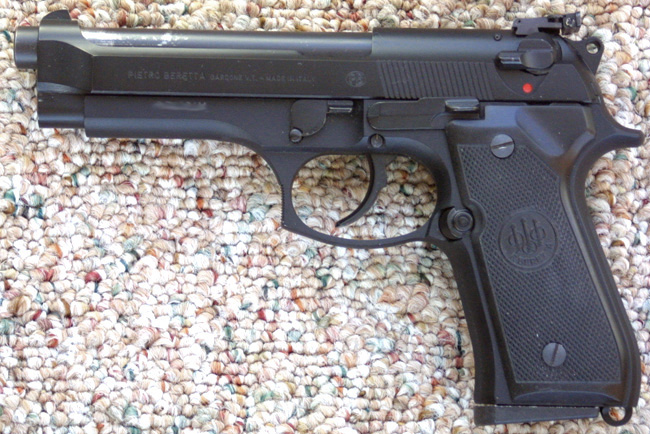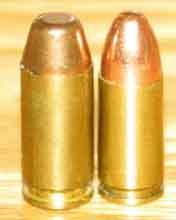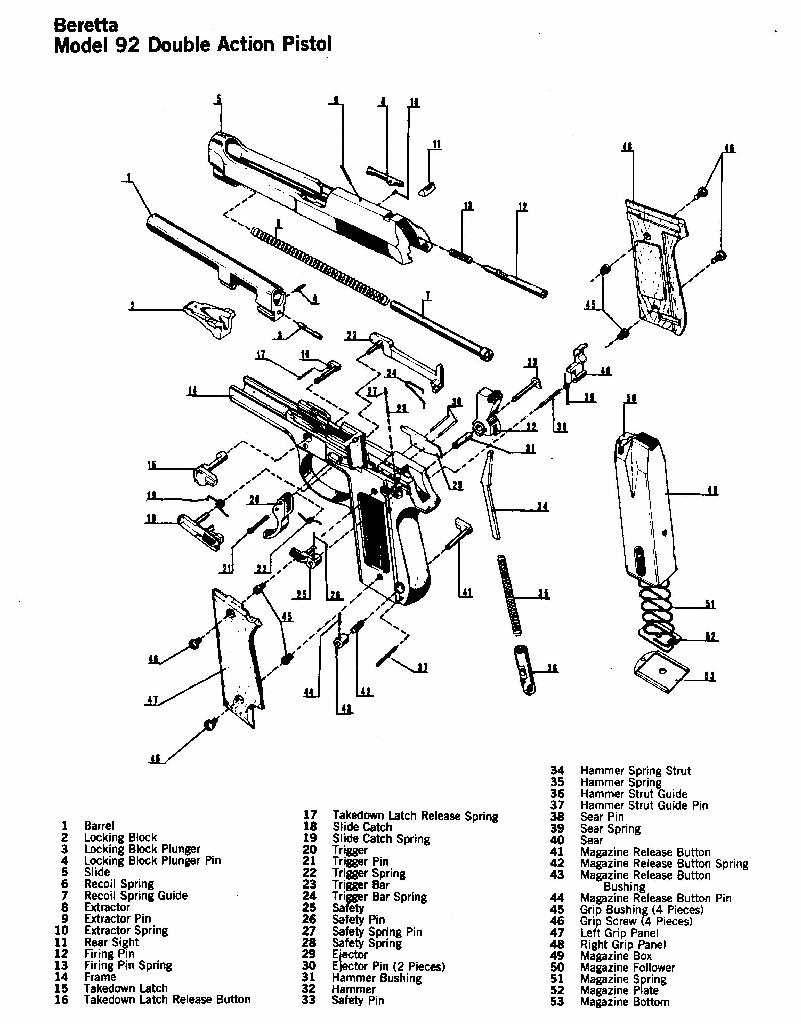 Beretta M-96
Beretta M-96
| Length overall | Barrel Length | Weight | Caliber | Action Type | Magazine Capacity |
| 8.5" | 4.9" | 34.4 oz. | .40S&W | Recoil Semi | 12+1 |
For the extra klutzy or foolhardy, Beretta makes a double action only gun. Law enforcement administrators in New York have recently shown the respect and esteem in which they hold the rank and file police officer, by issuing a double action only version of the Beretta with an extra heavy trigger pull so that even the most dull witted person could not fire this gun unintentionally. This same Group of administrators has had Glock develop what has come to be called the "New York Trigger" an extra heavy, long pulling trigger for the issue duty Glocks. The problem with these triggers is that they make precise shooting difficult if not impossible. This is a sorry attempt to replace good training with a mechanical substitute; it also discourages men from becoming highly trained, skilled shooters, because the hard trigger pulls make guns so equipped, incapable of precise shooting.

matter of weight and cost; but mainly it was one of logistics. It appeared that the outcome of the next major conflict would be decided in Europe, and the European The M-92 version of this gun, in 9mm, has been adopted by the U.S. Army, as the M-9 service issue handgun. Both the switch, and the new caliber, were not greeted with much enthusiasm, by fans of the classic M1911 handgun in 45 auto. The switch was made for a number of reasons. The military had been considering
Well, of course, nothing worked out according to plan. The Army soldiered on, with the M1911, for several more decades. The big war in Europe never happened, though numerous conflicts broke out in Asia, and the Middle East. The gun eventually procured is almost as heavy, and even bulkier than the old M1911, and logistically, we still have multiple calibers, since many American military units, as well as some allies, are still issued M1911 pistols. Well, what do you expect? It is, after all, the government.
The controversy continues. Most people, who are firearms enthusiasts, consider the 9mm to be inferior to the 45, though it is still a matter of considerable debate. There are many who point back to the time, a century ago, when the United States dropped the 45 Long Colt, in favor of the 38 revolver, only to find that the new caliber was ineffective against marauding Morros. A few of the old Peacemaker revolvers, in 45 Long Colt, were still around, and these proved be be quite effective, even where the new 38 caliber had failed. So the Army quickly switched back to the big bore pistol, when they adopted the M1911. There are those who shake their heads, considering that fanatical muslim fundamentalists, our most likely enemies for the next decade or two at least, will probably be about as tough to kill as had been fanatical morros. Quite a bit of the controversy could have been defused, by going with the 40 S&W version of the big Beretta.
There were other criticisms, however, relating to the guns themselves. For one thing, many here were not happy about procuring a major piece of military
The Germans, and the Italians were allies, during the Second World War, and there was much exchange of technology, manpower, and resources. Due to this sharing, when Beretta decided to embark upon the design of a full sized service pistol, their point of departure was the German P-38. The M-9, and all of the full sized Berettas, share the dual locking lug action of the old P-38. Since this action type requires no locking logs on the barrel, or down the top of the slide, the top of the slide can be milled away, leaving the action open. the lugs of the Beretta action, fit into a pair of grooves milled into either side of the slide, which can be seen in the photo above. This action type dispenses with the tilting barrel; but has not been widely adopted. Even Walther no longer uses it, in it's newest designs, having moved to a Browning style of action.
Disassembly
| Disassembly is begun, by depressing the release
on the right side of the frame. This allows the takedown lever to be rotated
downward. |
|
| The slide may then be pulled forward, off of
the frame. |
|
| Pressing forward on the guide rod, will release
it, and the recoil spring, allowing for their removal, by pulling up and back. |
|
| Pressing on the locking pin, of the barrel
toggle, will permit it's release from the slide. |
|
| The barrel may then be pulled up and out of
the slide. |
|
| The Beretta M-96, stripped for cleaning. |
